Physical Address
304 North Cardinal St.
Dorchester Center, MA 02124
Psoriasis is a relatively common immune-mediated disorder, which occurs overall in 0.5% to 0.8% of pediatric patients, with a linear increase in prevalence by age from 0.2% at 2 years to 1.2% at 18 years. Psoriasis rarely is present at birth. , Approximately one-third of adults with psoriasis noted the onset of disease during the first 2 decades of life. As in the adult population, psoriasis occurs most often in white children. The severity of the condition may vary from a life-threatening neonatal pustular or exfoliative dermatosis to a mild, localized disorder that causes no distress. Psoriasis usually follows an irregularly chronic course marked by remissions and exacerbations of unpredictable onset and duration. It negatively affects the quality of life of both the pediatric patient and the parents. ,
Both complex genetic and environmental factors contribute to the risk of psoriasis. An immediate family history has been reported in 30% to 49% of pediatric patients, , and the risk of occurrence in monozygotic twins is two to three times that of dizygotic twins. The major genetic determinant is PSOR1 (35% to 50% of patients), which is within the major histocompatibility complex on chromosome 6. Early-onset psoriasis has been linked to human leukocyte antigen (HLA) antigen Cw6, and 73.7% of patients with guttate psoriasis show HLA Cw6 antigen, in contrast to a rate of 7.4% in the general population. Autosomal dominant mutations in caspase recruitment domain family member 14 ( CARD14 ; PSOR2 ) also lead to a psoriatic (or pityriasis rubra pilaris [PRP]) phenotype. Deficiency of IL-36 receptor antagonist (DITRA) from variants in IL36RN is the major cause of generalized pustular psoriasis (GPP) in patients without plaque psoriasis. At least 64 susceptibility loci for psoriasis have now been identified, including genes regulating T-cell function, especially interleukin (IL)-23 function, tumor necrosis factor (TNF) activation, nuclear factor (NF)-κB signaling, T-helper (Th) 2 cytokines, interferon (IFN)-mediated antiviral responses, and macrophage activation.
Evidence that psoriasis is a Th17/IL-23 pathway–mediated disorder is also based on the success of targeted therapy, such as cyclosporine and inhibitors of TNF, IL-23p40 and IL-23p19, and IL-17/ IL-17 receptor. The majority of T cells in psoriatic plaques are CD45RO+ memory-effector T cells that migrate into skin exposed to an antigenic trigger. The innate immune system plays a key role in psoriasis, initiating a cascade that involves toll-like receptor-mediated activation of plasmacytoid dendritic cells, included by complexes that contain antimicrobial peptides. , The activated dendritic cells express IL-12 and IL-23, leading to Th1 and Th17 cell expression of TNF-α/IFN-γ and IL-17/IL-22, respectively. These cytokines stimulate the keratinocytes to produce more IL-1β and IL-6, TNF-α, chemokines, and antimicrobial peptides, further contributing to immune activation and cutaneous inflammation.
Skin injury and streptococcal infections , are well-known environmental triggers for psoriasis. Additionally, the occurrence of psoriasis has been linked to Staphylococcus aureus infection and Kawasaki disease, suggesting a role for superantigens. Psoriasis has been triggered by administration of growth hormone therapy, IFN (e.g., for chronic hepatitis), and other drugs (particularly, lithium, β-blockers, antimalarials, and sodium valproate). Flares of psoriasis have also clearly been linked to psychological and physical stress.
Classic lesions of psoriasis consist of round, brightly erythematous, well-marginated plaques covered by a characteristic grayish or silvery-white (mica-like, or “micaceous”) scale, attached primarily at the center rather than the periphery of lesions. Psoriatic papules coalesce to form plaques that measure 1 cm or more in diameter. The disorder may present as solitary lesions or countless plaques in a generalized distribution ( Fig. 4.1 ). Follicular-based scaling occurs in psoriasis ( Figs. 4.2 and 4.3 ), generally in the presence of more typical lesions, and must be differentiated from PRP. Lesions are usually bilaterally symmetric with a distinct predilection for the scalp ( Fig. 4.4 ) and hairline ( Fig. 4.5 ), elbows, knees and legs ( Figs. 4.6 and 4.7 ), and lumbosacral and anogenital regions. However, lesions may also be found on the trunk or in a flexural distribution with involvement of the axillae ( Fig. 4.8 groin ( Figs. 4.9, 4.10 and 4.11 ), and umbilical region. Inverse psoriasis reflects lesions in these flexural regions, which is seen without any extensor surface involvement in 2.8% to 6.0% of patients or in association with only regional involvement in 30% of patients. Lesions may also be limited to the palms ( Fig. 4.12 , A ) and soles ( Fig. 4.12 , B ). A linear variant that courses along the Blaschko lines rarely occurs ( Fig. 4.13 ) and may be associated with more extensive psoriasis (usually with later onset) and/or juvenile psoriatic arthritis (JPsA).
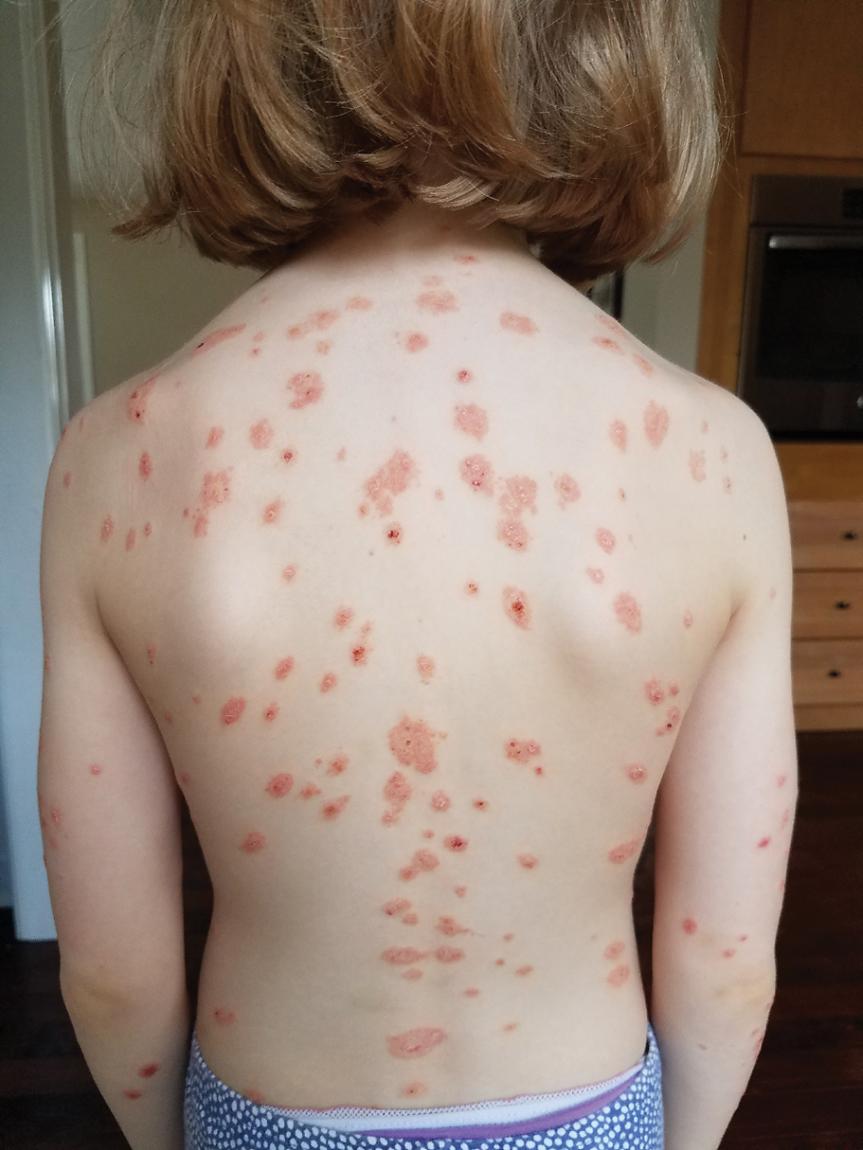
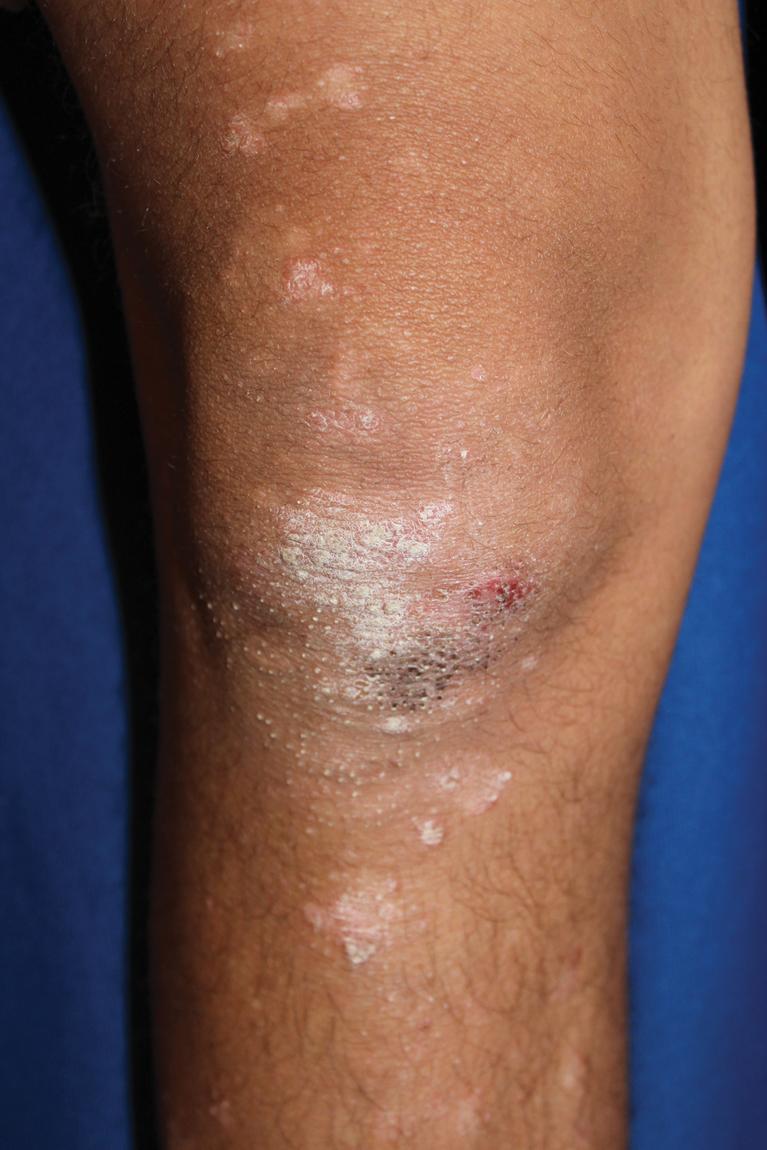
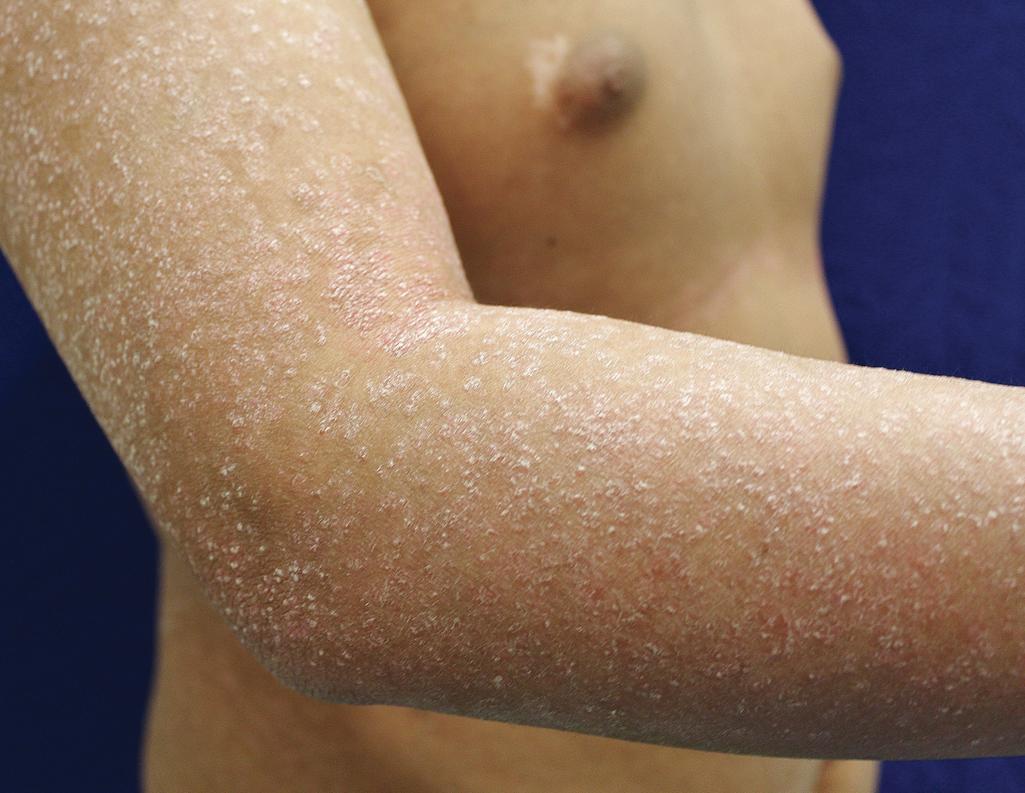
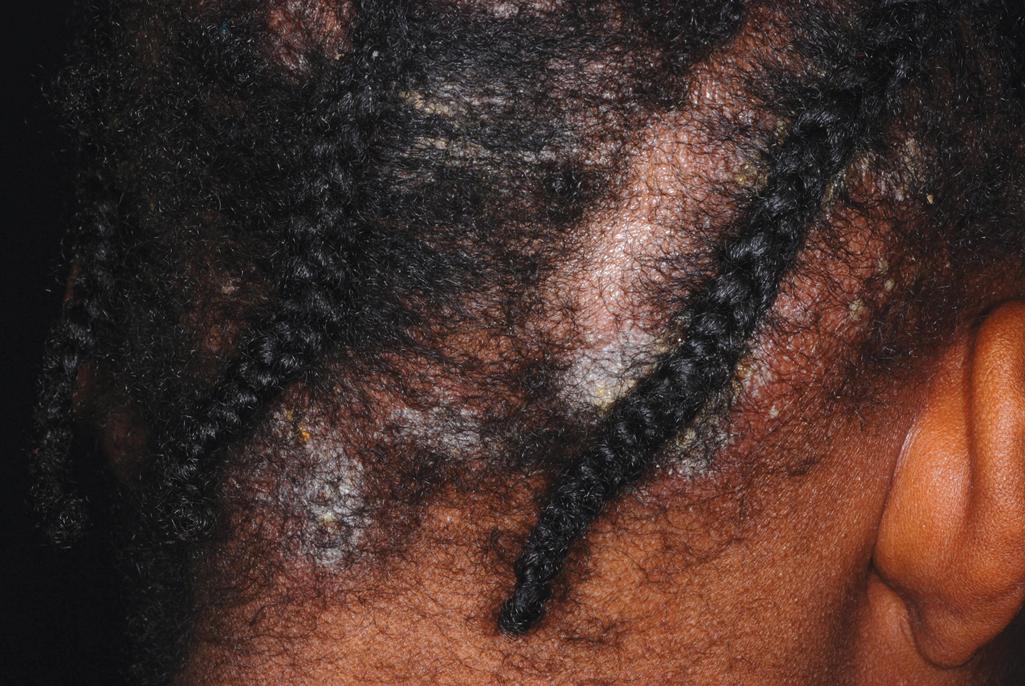
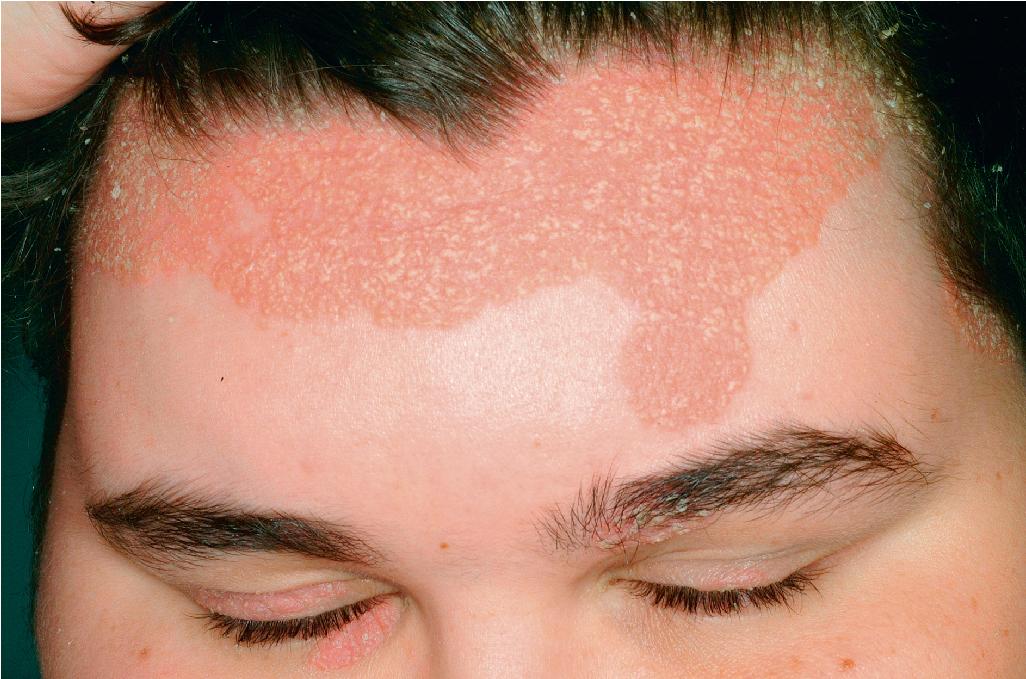
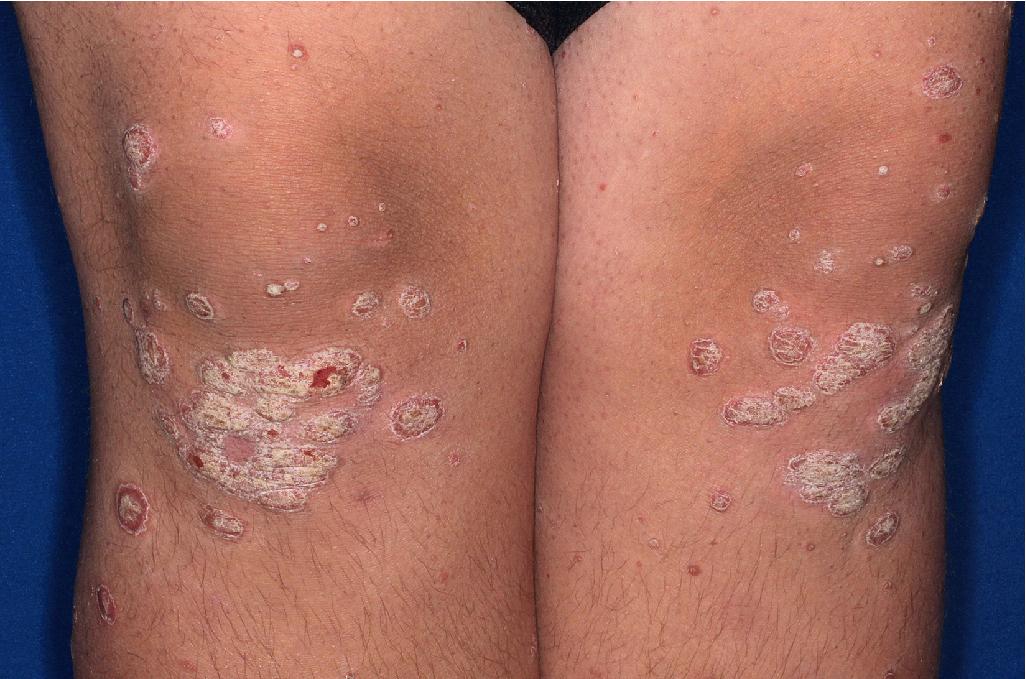
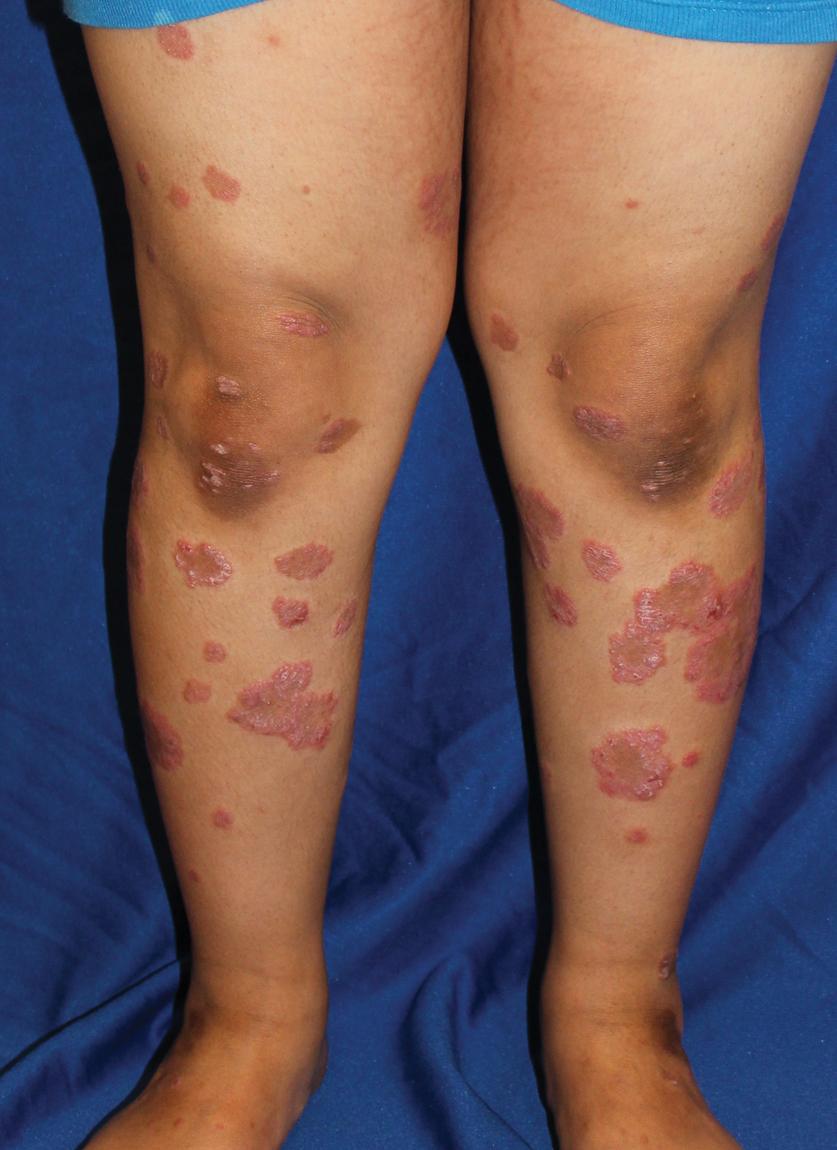
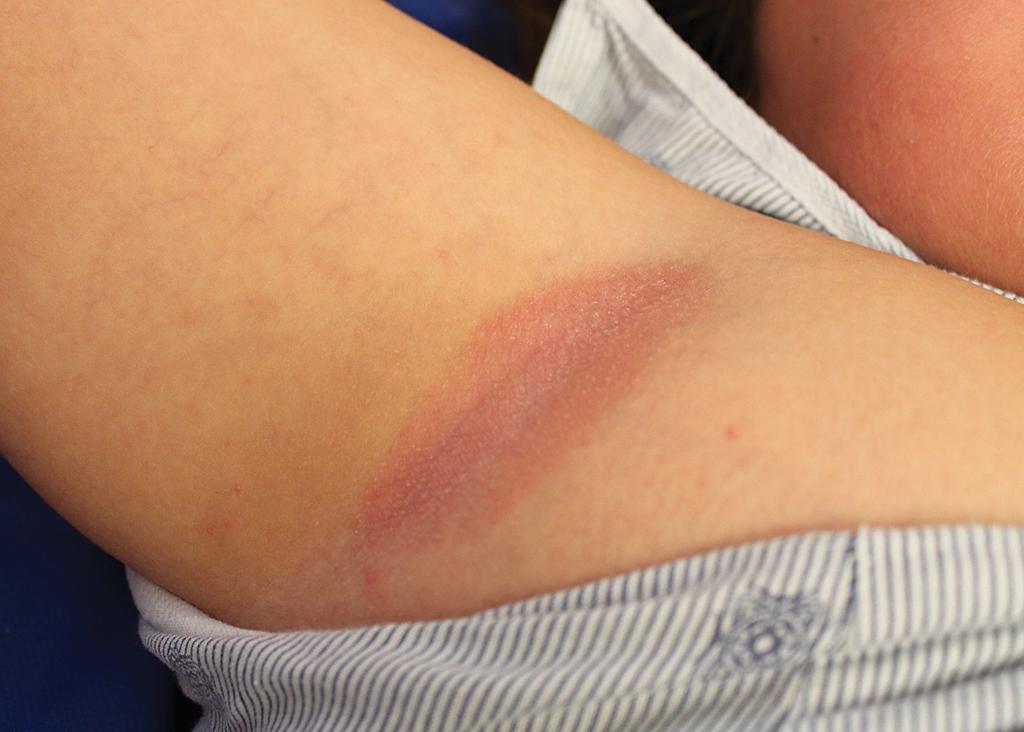

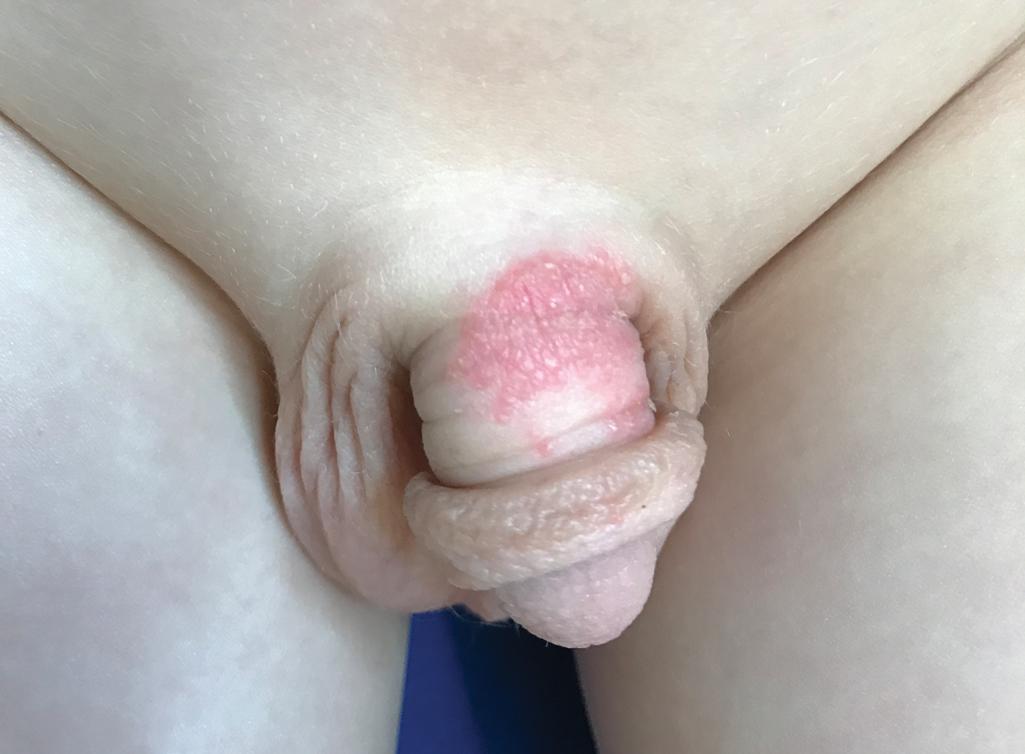
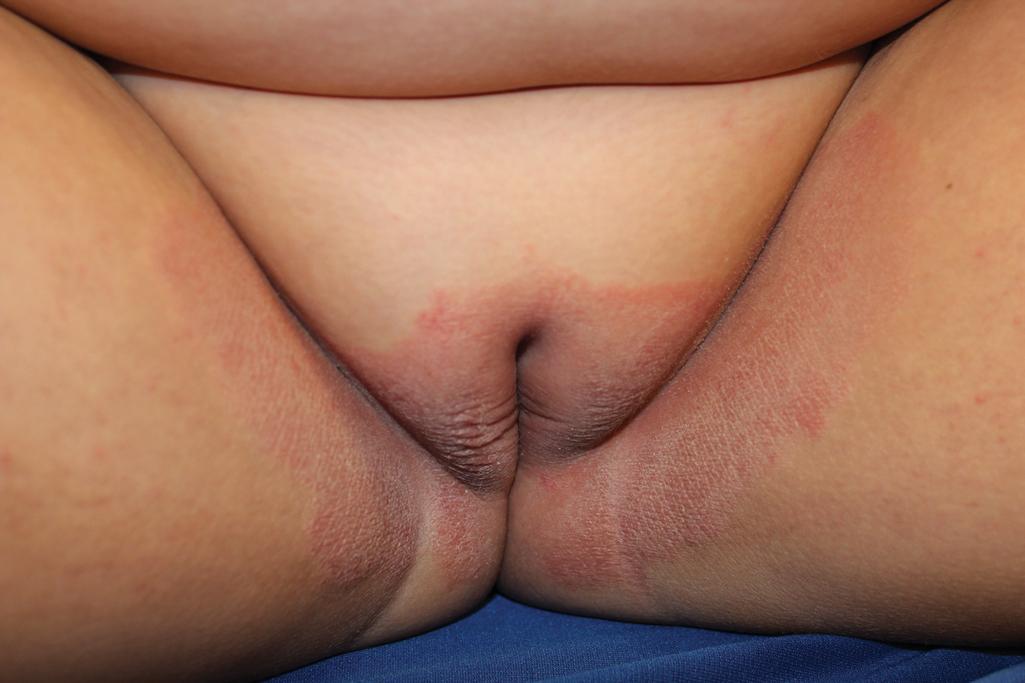
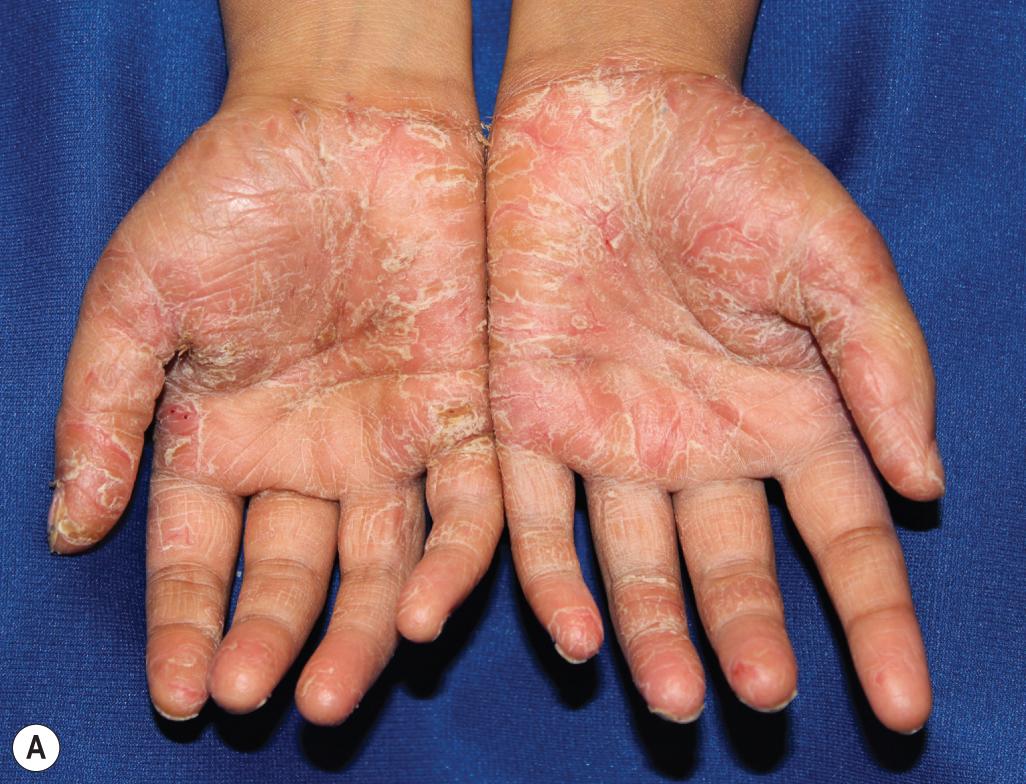
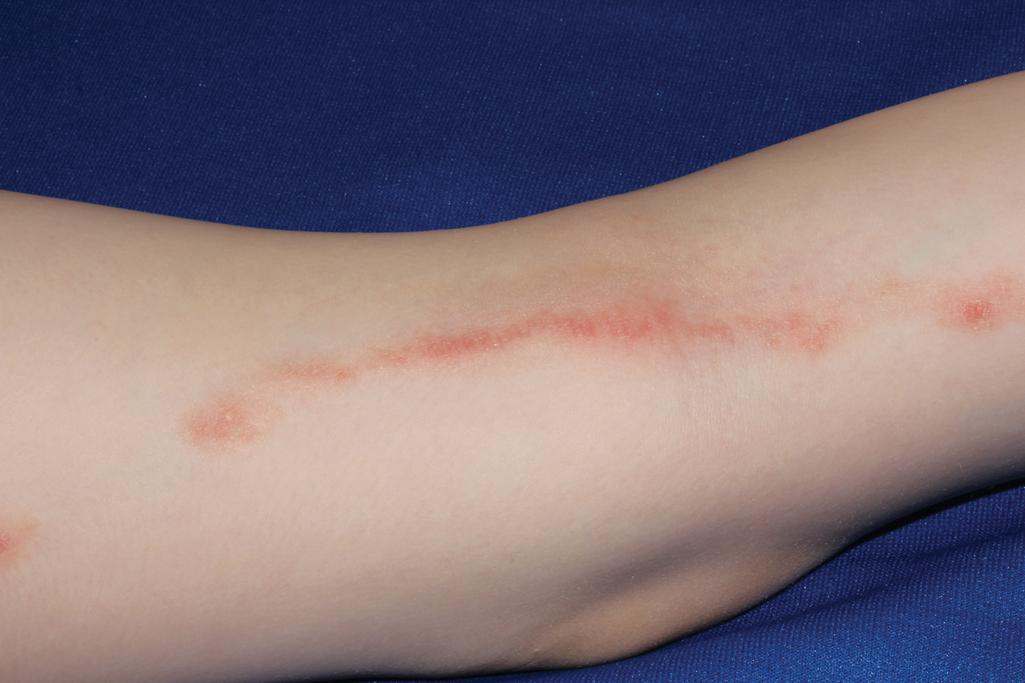
Removal of psoriatic scale results in fine punctate bleeding points. This phenomenon (termed the Auspitz sign ) is highly characteristic and relates to the rupture of capillaries high in the papillary dermis of lesions. The Koebner phenomenon (an isomorphic response) is commonly seen in psoriasis ( Fig. 4.14 ) but also in verrucae, Rhus dermatitis, lichen planus, lichen nitidus, Darier disease, and PRP. This valuable diagnostic sign of psoriasis describes the occurrence of skin lesions at sites of local injury, such as after irritation (a scratch or sunburn) ( Fig. 4.15 ), a surgical scar, or a preexisting disease such as seborrheic or atopic dermatitis. The Koebner phenomenon likely is responsible for psoriasis of the diaper region and around enteral feeding tubes. A peripheral white ring is often the first sign of involution of a psoriatic plaque (termed a Woronoff ring ). However, when the central portions of the plaques resolve, the involuting lesions may appear nummular (small circles), annular (with central clearing) ( Fig. 4.16 ), gyrate, or arcuate (semicircular).
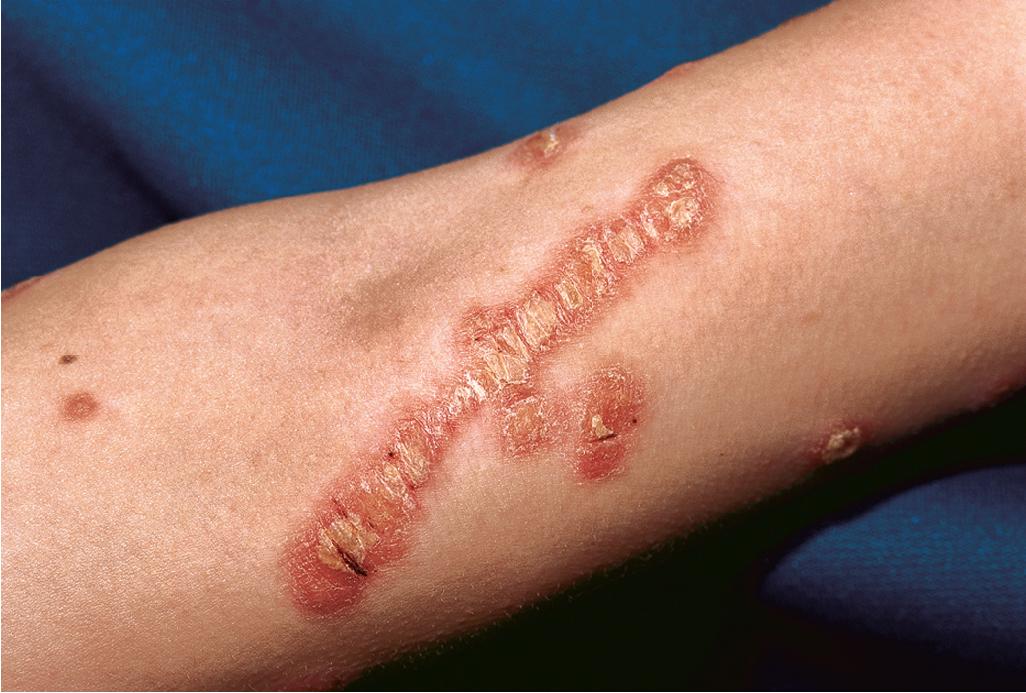
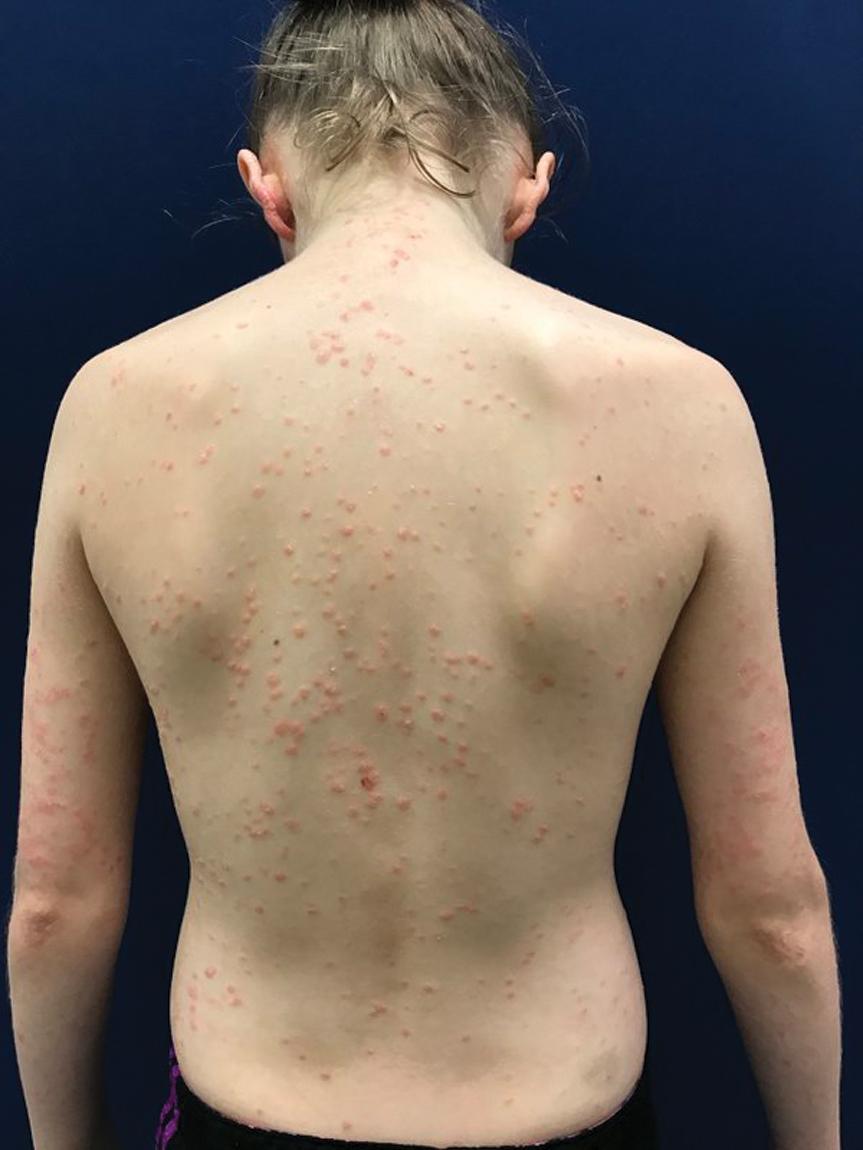
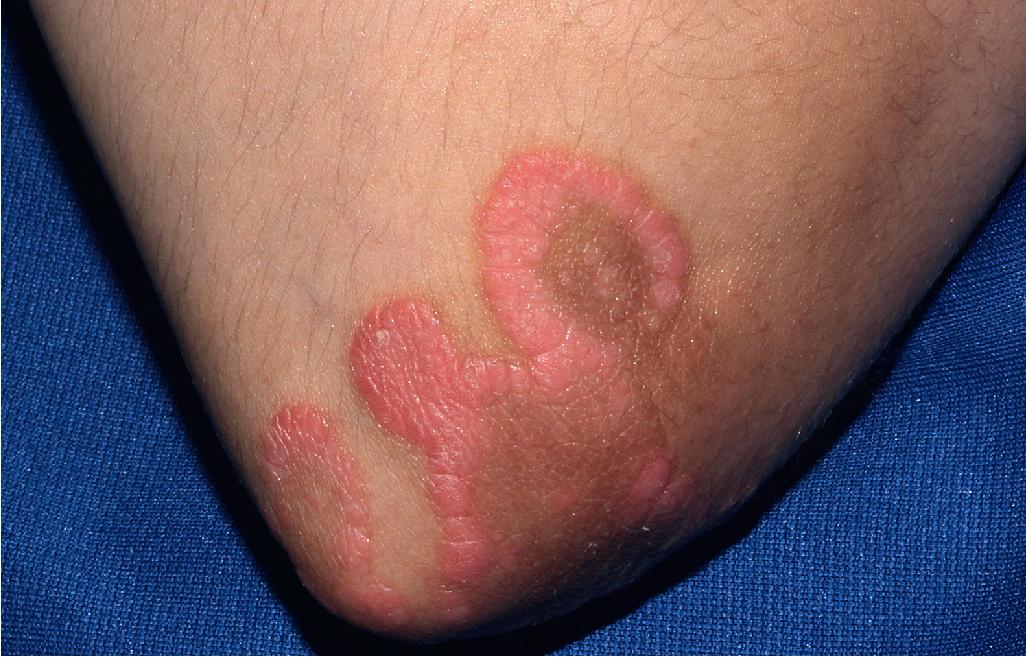
Facial psoriasis is more common in children than in adults and occurs without other involvement in 4% to 5% of patients. Involvement of the periorbital area is most typical ( Fig. 4.17 ), and lesions may be subtle, leading to confusion with atopic dermatitis ( Fig. 4.18 ). The plaques of psoriasis tend to be more clearly delineated than patches of atopic dermatitis, are less pruritic, and may show an annular configuration. It should be noted, however, that at least 5% of pediatric patients show an eczema/psoriasis overlap, either showing typical lesions of both atopic dermatitis and psoriasis or lesions that are intermediate (e.g., nummular and psoriasiform). Almost all patients with the overlap have a family history of both atopic disease and psoriasis. Although mucosae do not tend to be affected in psoriasis, geographic tongue is a frequently unrecognized feature of psoriasis in many children ( Fig. 4.19 ). Geographic tongue, with or without GPP, has been associated with mutations in IL36RN or, if without a variant in IL36RN , with a reduction in the ratio of expression of IL-36 receptor to IL-36γ in tongue mucosa.
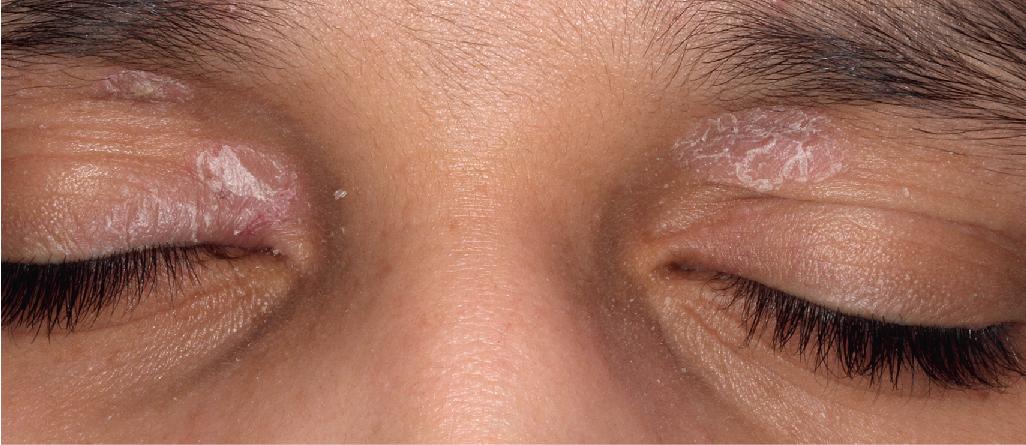
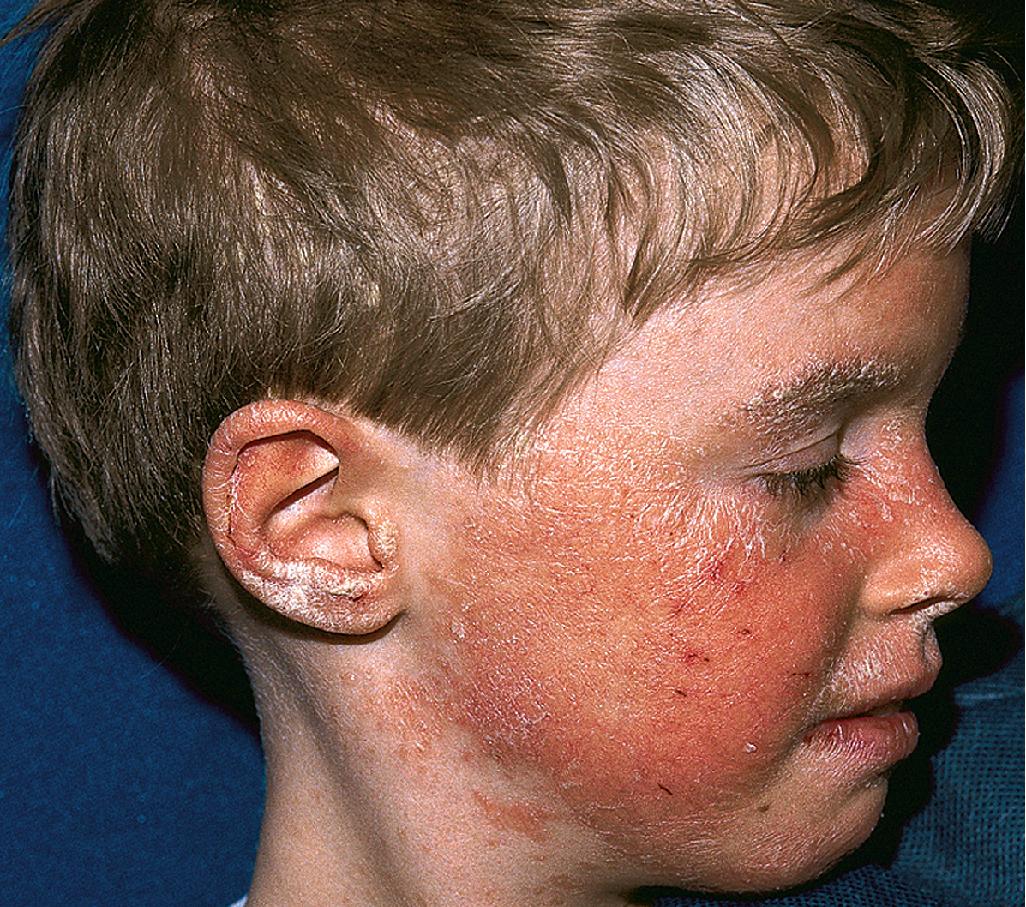
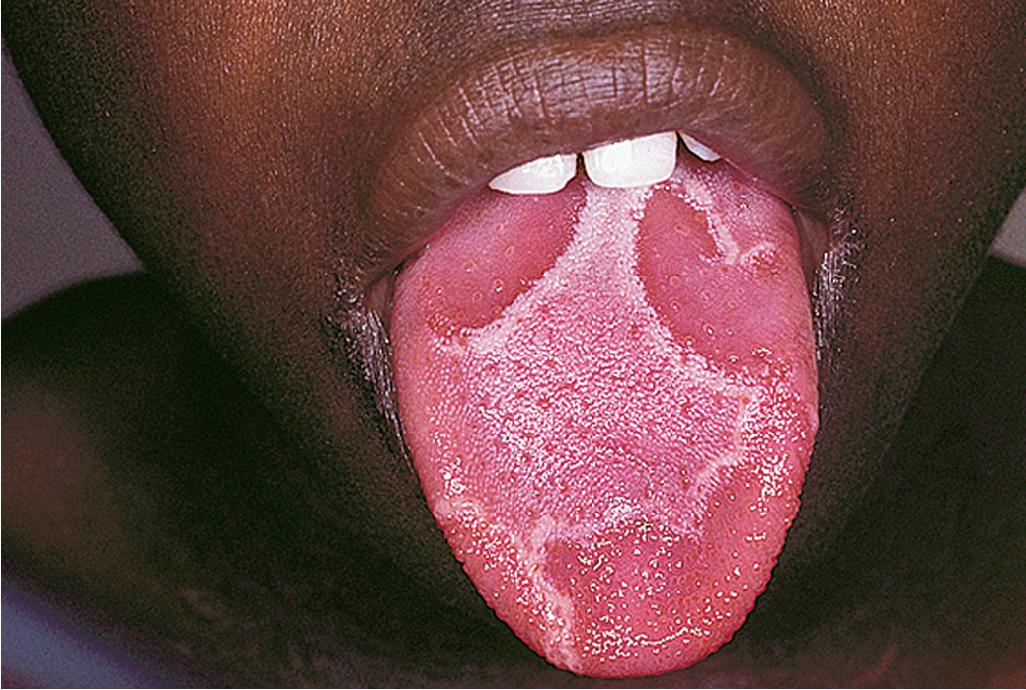
Seen in up to 44% of pediatric patients, guttate psoriasis generally occurs in children and young adults and is often the first manifestation of psoriasis. Lesions are drop-like (guttate), round or oval, measure from 2 to 6 mm in diameter ( Fig. 4.20 ), and generally occur in a symmetric distribution over the trunk and proximal aspects of the extremities (occasionally the face, scalp, ears, and distal aspects of the extremities). Guttate psoriasis is often, but not necessarily, triggered by group A streptococcal infection of the oropharynx or perianal area , Two-thirds of patients with guttate psoriasis give a history of an upper respiratory tract infection 1 to 3 weeks before the onset of an acute flare of the disorder. Although guttate psoriasis may clear spontaneously ( Fig. 4.21 ), 40% of affected children progress to the plaque type, which may ultimately be more severe psoriasis than in children with plaque disease initially.

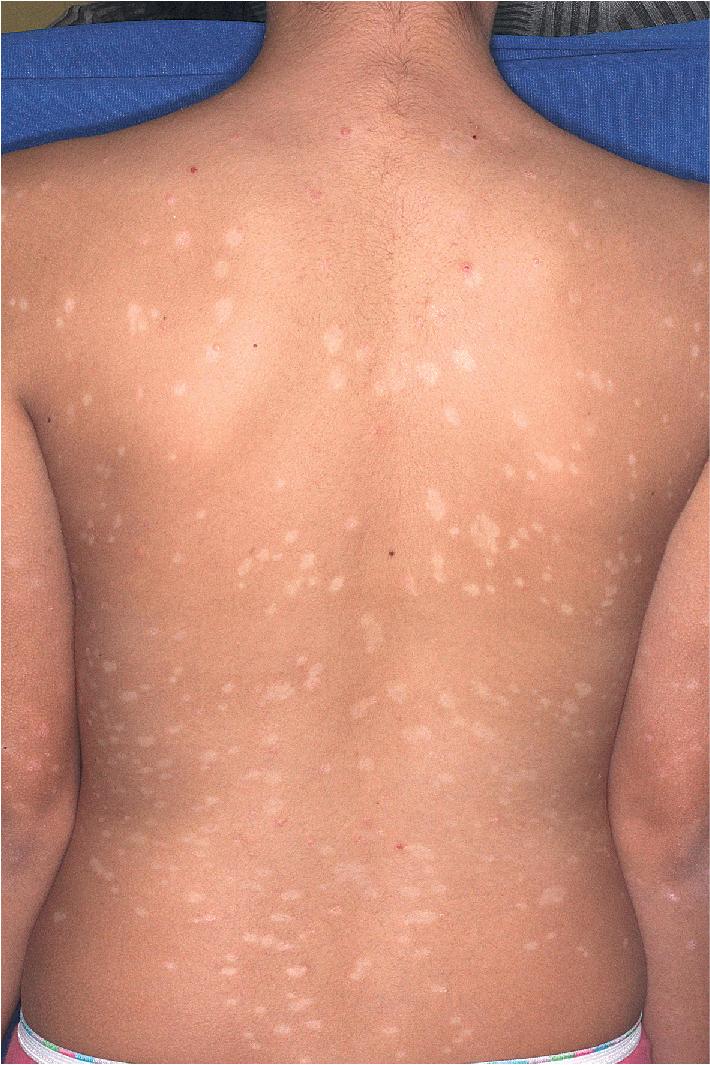
The scalp is commonly the initial site of psoriatic involvement (20% to 40%), and scalp psoriasis occurs more often in affected girls than boys, perhaps due to the Koebner phenomenon associated with combing, brushing, and vigorous shampooing. Most typical are well-demarcated, erythematous plaques with thick, adherent silvery scales similar in appearance to those on other parts of the body ( Fig. 4.22 ). However, psoriatic lesions of the scalp, eyebrows, and ears (the superior and postauricular folds and external auditory meatus) may instead be greasy and more salmon-colored, suggesting a diagnosis of seborrheic dermatitis. In this variant, often termed sebopsoriasis, lesions may present with features of both seborrhea and psoriasis. Whereas lesions of seborrheic dermatitis generally remain within the hairline, lesions of psoriasis often extend beyond the confines of the hairline onto the forehead (see Fig. 4.5 ), preauricular, postauricular, ear ( Fig. 4.23 ), and nuchal regions. Lesions of the postauricular area commonly fissure ( Fig. 4.24 ). Rapid response to therapy further distinguishes seborrhea from psoriasis. Another scaling disorder of the scalp that may be a variant of psoriasis is pityriasis amiantacea (asbestos-like) ( Fig. 4.25 ) ; the alternative term, tinea amiantacea, should be abandoned, because the disorder is unrelated to dermatophyte infection. Pityriasis amiantacea usually begins in school-aged children and adolescents as large plates of scale firmly adherent to the hair and scalp. Focal hair loss and secondary infection may be associated. Most patients have no other signs of psoriasis, and later development of more typical psoriasis only occurs in 2% to 15% of patients. Pretreatment of affected scalp areas with fluocinolone 0.01% oil daily for at least an hour and then shampooing with a keratolytic shampoo is usually effective.
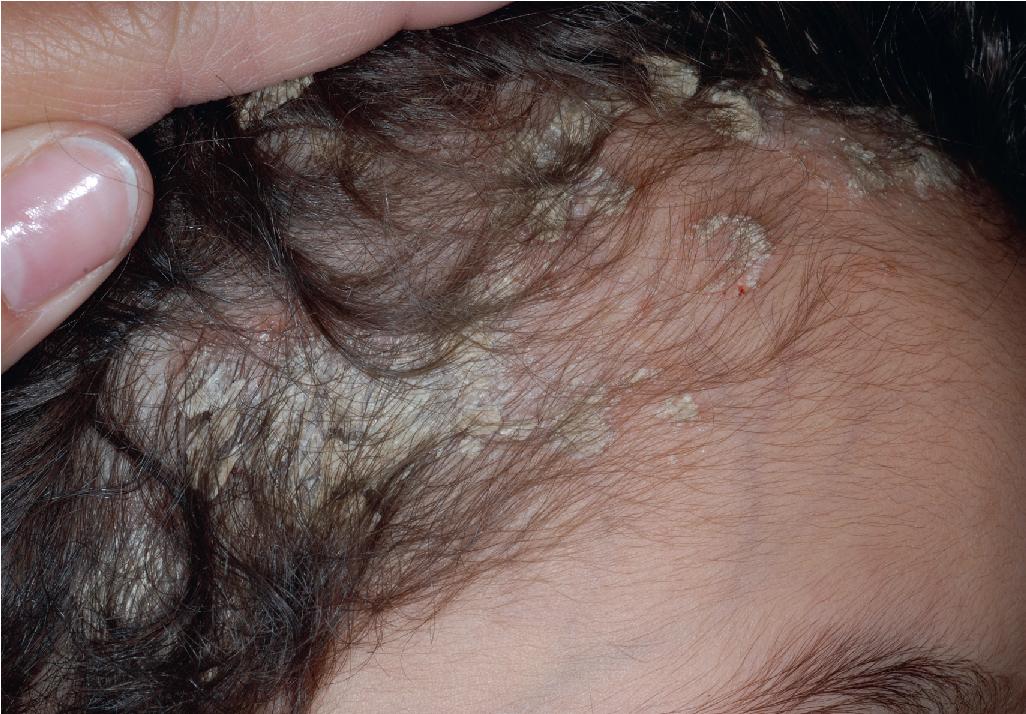
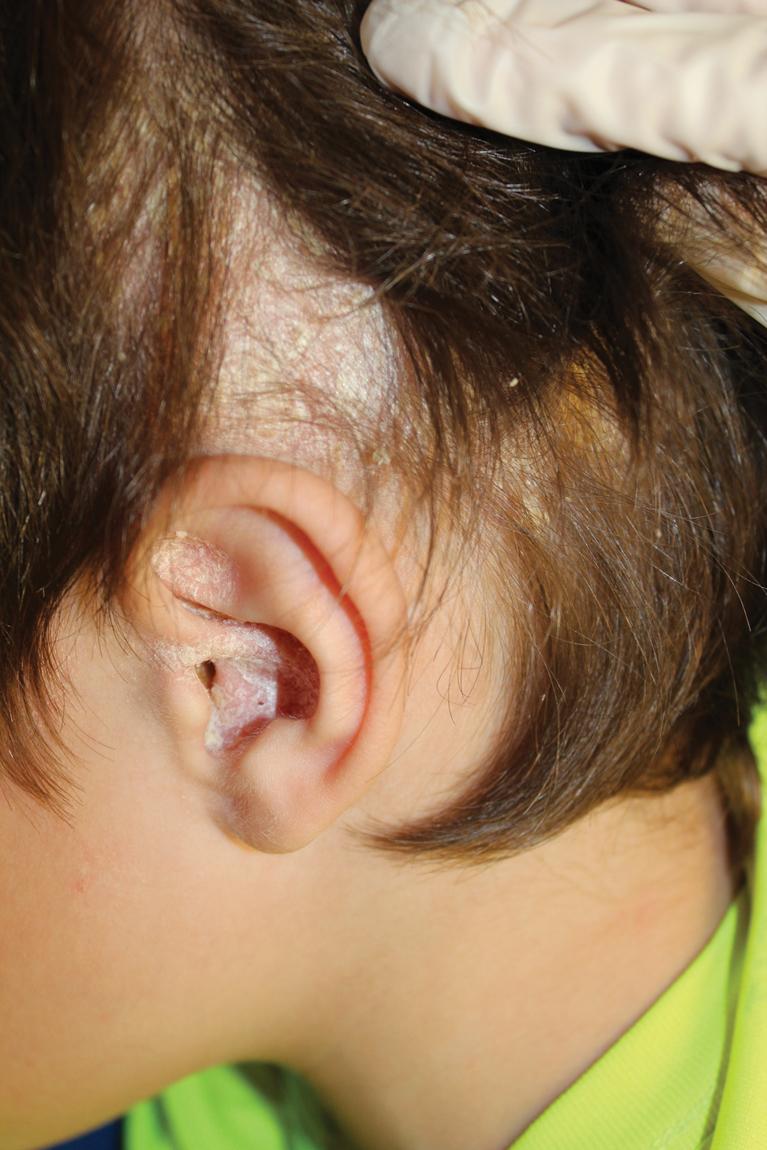
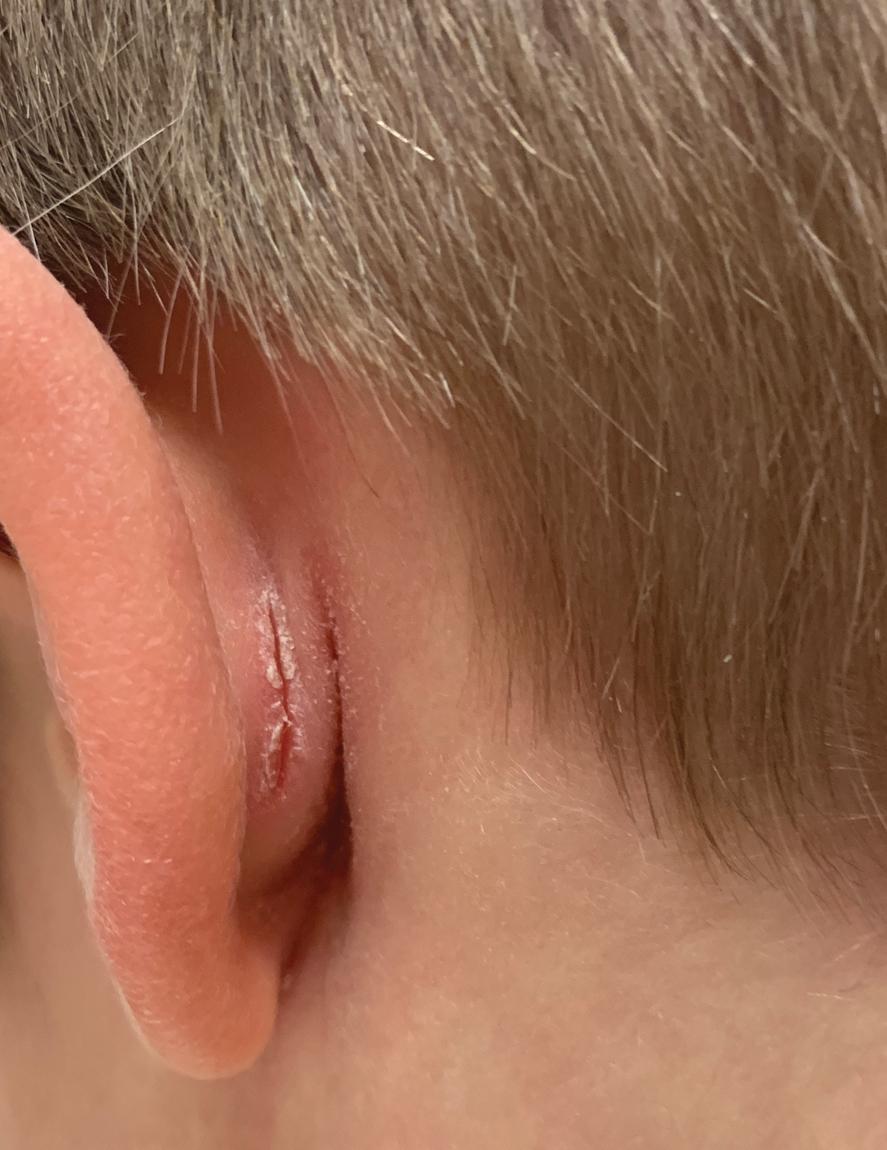
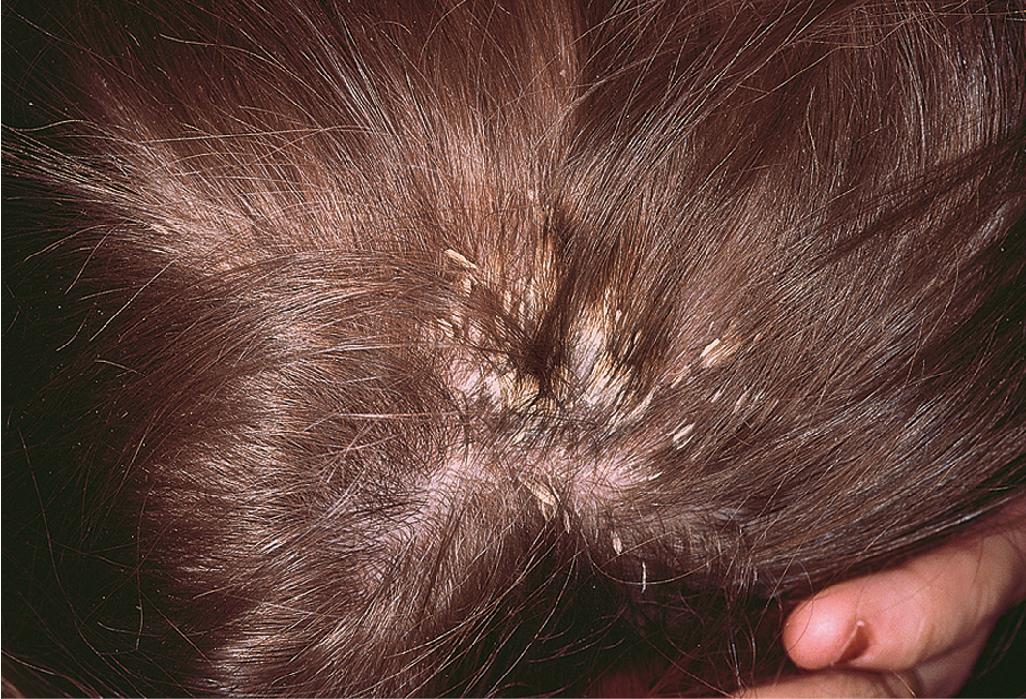
Psoriatic diaper rash (see Fig. 2.32 ) with or without dissemination is the presenting manifestation in 13% and 4% of patients, respectively. This form of psoriasis must be differentiated from infantile seborrheic dermatitis (see Chapter 3 ) and, when localized to the diaper area, other forms of diaper dermatitis (see Chapter 2 ). The sharply defined plaques, bright-red coloration, shininess, and larger, drier scales of psoriasis help to differentiate it from seborrheic dermatitis. Many infants with diaper-area psoriasis also show psoriasiform lesions elsewhere ( Fig. 4.26 ). Because of the increased moisture of the occluded diaper region, scale may not be visible clinically but can be revealed by scraping the area gently. The incidence of psoriasis in the diaper area during infancy probably reflects the Koebner phenomenon, triggered by trauma from exposure to stool and urine, and resolves when toilet trained. Nevertheless, boys and girls out of diapers may also show genital area involvement. Of prepubertal girls with a genital region complaint, 17% had psoriasis particularly involving the vulva, perineum, and natal cleft.
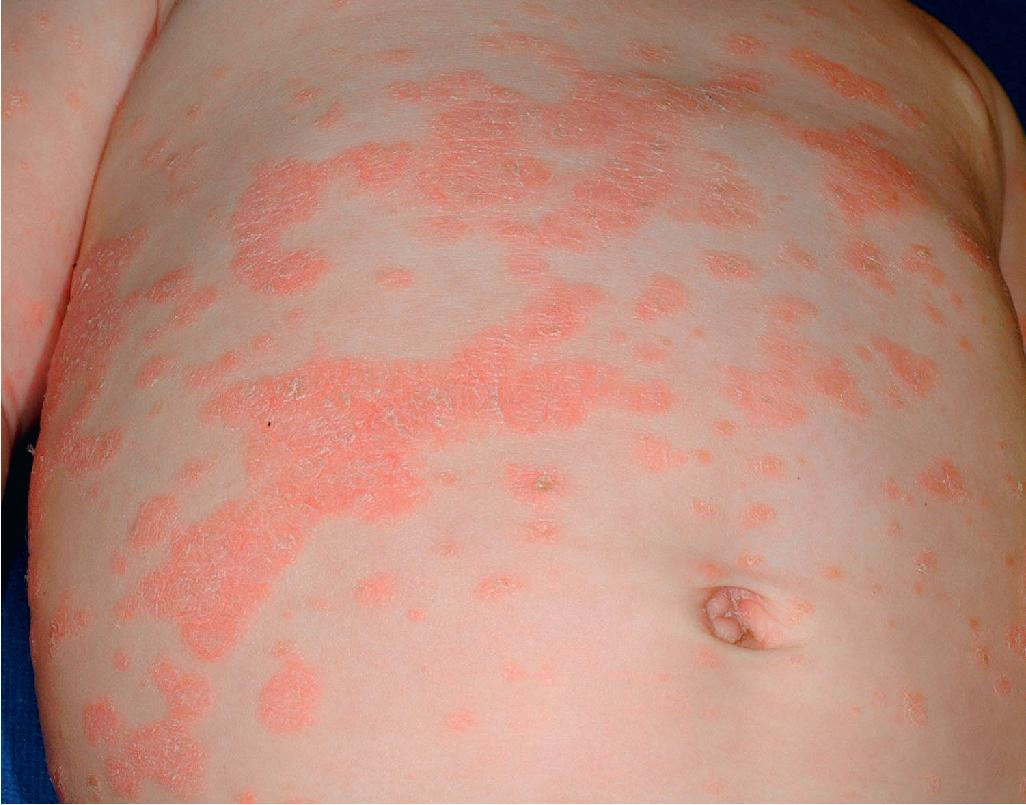
Although statistics vary, the nails appear to be affected in 25% to 50% of pediatric patients with psoriasis, more commonly during the second decade of life and in males ( Figs. 4.27 , 4.28 , and 4.29 ). Nail involvement has also been associated with more severe disease, palmoplantar psoriasis, and psoriatic arthritis. Pitting is most common (69% to 92% with nail involvement), manifesting as small, irregularly spaced depressions measuring less than 1 mm in diameter. Larger depressions or punched-out areas of the nail plate may also be noted. These pits are thought to represent small intermittent psoriatic lesions in the nail matrix region that forms the superficial layers of the nail plate. Psoriatic pitting may be indistinguishable from the nail pitting seen in alopecia areata (see Chapter 7 ) and atopic dermatitis (see Chapter 3 ), although other features assist in differentiating these disorders. Discoloration (especially leukonychia in 73% with nail changes), longitudinal ridges, onycholysis (separation of the distal and lateral nail plate edges), and subungual hyperkeratosis (lifting of the nail plate with nail thickening) (see Fig. 4.29 ) are also commonly seen. Secondary bacterial, candidal, and occasionally dermatophyte infections occur with increased incidence.
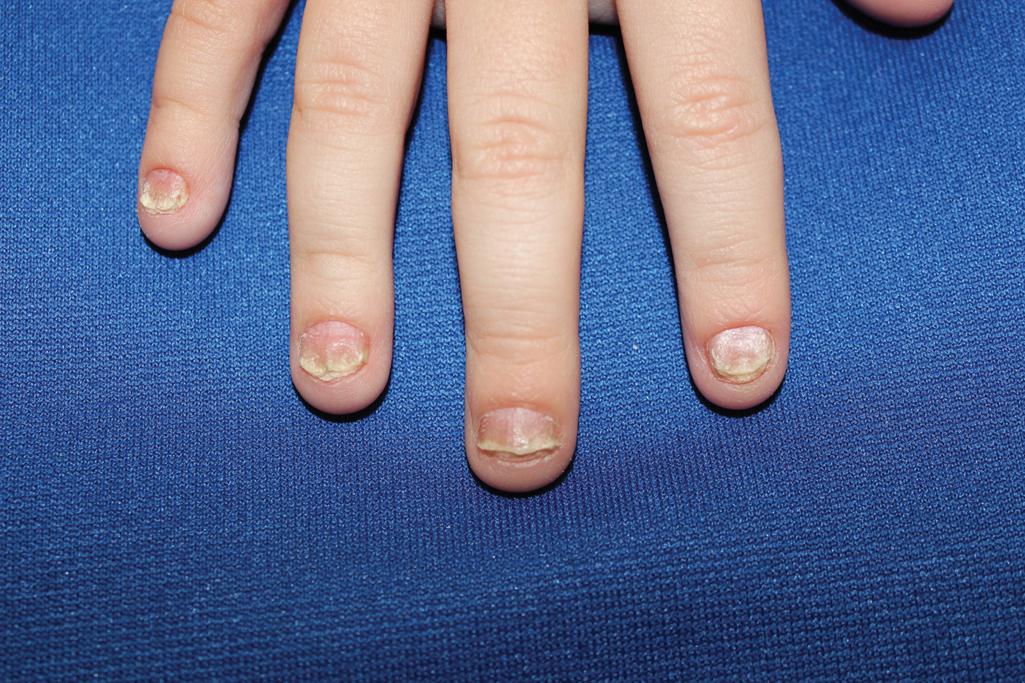
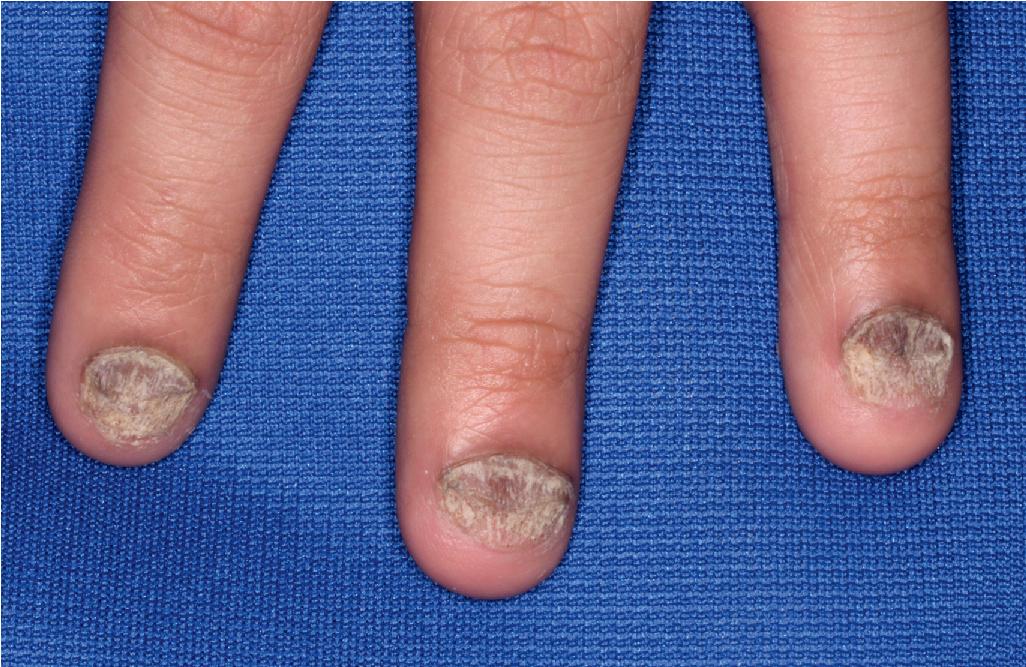
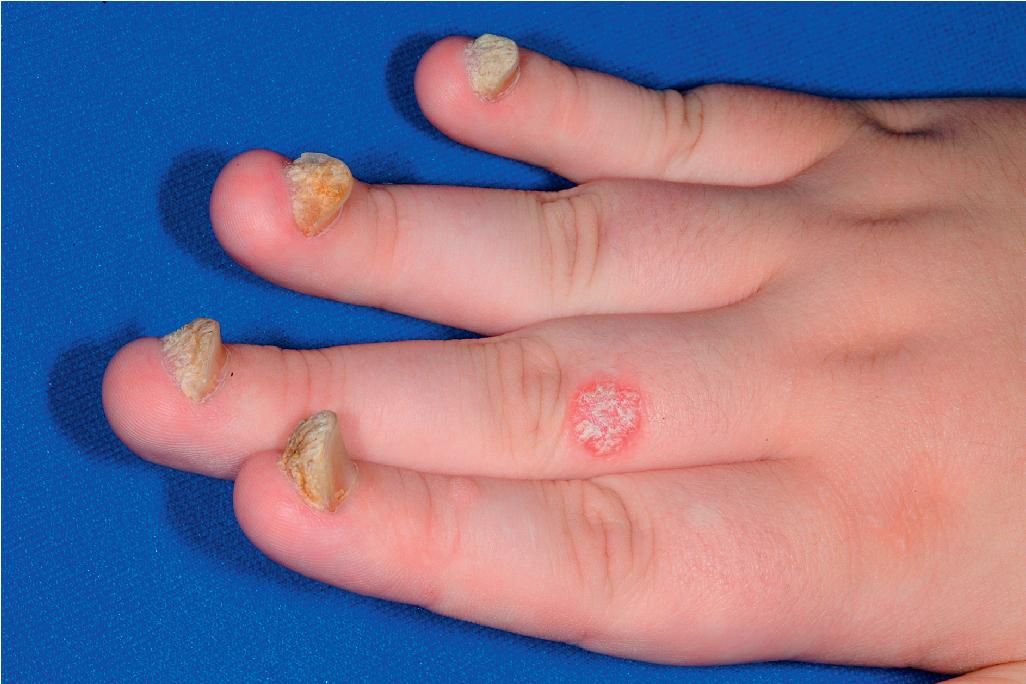
Pustular psoriasis and erythrodermic (exfoliative) psoriasis are the most severe variants of childhood psoriasis, , but occur in only approximately 1% of pediatric patients with the disease. Pustular psoriasis has been described as early as the first week of life. , Although much less common than plaque and guttate psoriasis, pustular psoriasis is more commonly the first manifestation of psoriasis in affected infants and children than in adults.
The erythema of pustular psoriasis develops and rapidly becomes studded with superficial, pinpoint-sized up to 2- or 3-mm pustules ( Fig. 4.30 ). The lesions of GPP in children show an annular morphology in 60% of patients ( Fig. 4.31 ). , Sheets of erythema and pustulation can involve the flexures, genital regions, webs of the fingers, and periungual areas. The cutaneous inflammation typically progresses in an explosive manner from discrete sterile pustules to crusts and ultimately to generalized exfoliative dermatitis. More than 90% of the skin shows intense erythema, massive exfoliation, and associated abnormalities of temperature and cardiovascular regulation. The nails often become thickened or separated by subungual lakes of pus. Mucous membrane lesions in the mouth and tongue are not uncommon. Fever, malaise, and anorexia are typically associated with GPP. Affected children may show failure to thrive. The predominant histologic feature on biopsy is the large intraepidermal unilocular pustule containing polymorphonuclear leukocytes (the spongiform pustules of Kogoj) with little, if any, surrounding spongiosis or inflammation. Although staphylococcal infection may at times occur as a secondary complication, lesions are usually sterile.

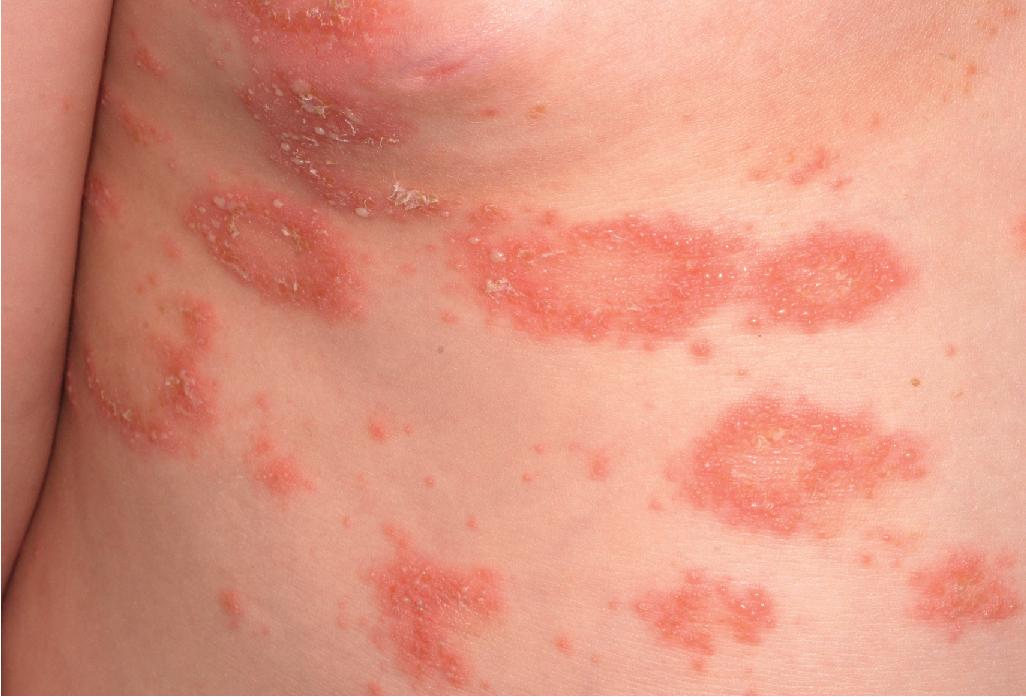
Deficiency of IL-36 receptor antagonist (encoded by IL36RN ) or DITRA is an important cause of GPP in patients without plaque psoriasis. Early age of onset is a feature of individuals with homozygous or compound heterozygous IL36RN variants. DITRA in babies is often characterized by irritability, tender skin, diarrhea, dysphagia, and failure to thrive in association with their pustular psoriasis and/or exfoliative erythroderma. In one study of 66 children with pediatric-onset GPP without plaque psoriasis, other signs of DITRA included severe cutaneous inflammation, confluent areas of purulence, and perianal and flexural erosions. Neutrophilia and thrombocytosis are common, but other organs are not involved. Poor response to standard therapy and early recurrence after discontinuation of medication are other clues to diagnosis. The discovery of IL-36 pathway activation in DITRA has led to the recognition that IL-36 is important in driving both pustular and plaque psoriasis. Given that individuals with knockout mutations in the IL-36 receptor have normal immune function, inhibition of IL-36 has emerged as a new potential therapeutic approach.
Although pustular psoriasis is most often generalized, it can be limited to the palms and soles (pustulosis palmaris et plantaris) or to fold areas. Pustulosis palmaris et plantaris is a bilaterally symmetric, chronic pustular eruption on the palms and soles characterized by deep-seated 2- to 4-mm sterile pustules that develop within areas of erythema and scaling. Plaque or pustular psoriasis may be seen elsewhere on the body. Within several days the pustules resolve and leave a yellow-brown scale that is generally shed within 1 or 2 weeks. Phases of quiescence and exacerbation are characteristic, and exfoliating crusted lesions may be seen concurrently with newly developing pustules. Pustular psoriasis localized to the neck fold tends to have its onset during infancy. The disorder is often misdiagnosed as dermatitis caused by bacterial or candidal infection ( Fig. 4.32 ). Biopsy facilitates making the diagnosis, particularly given that many lesions clinically appear more papular than pustular. Other fold areas may be affected, and dissemination to GPP is not uncommon.
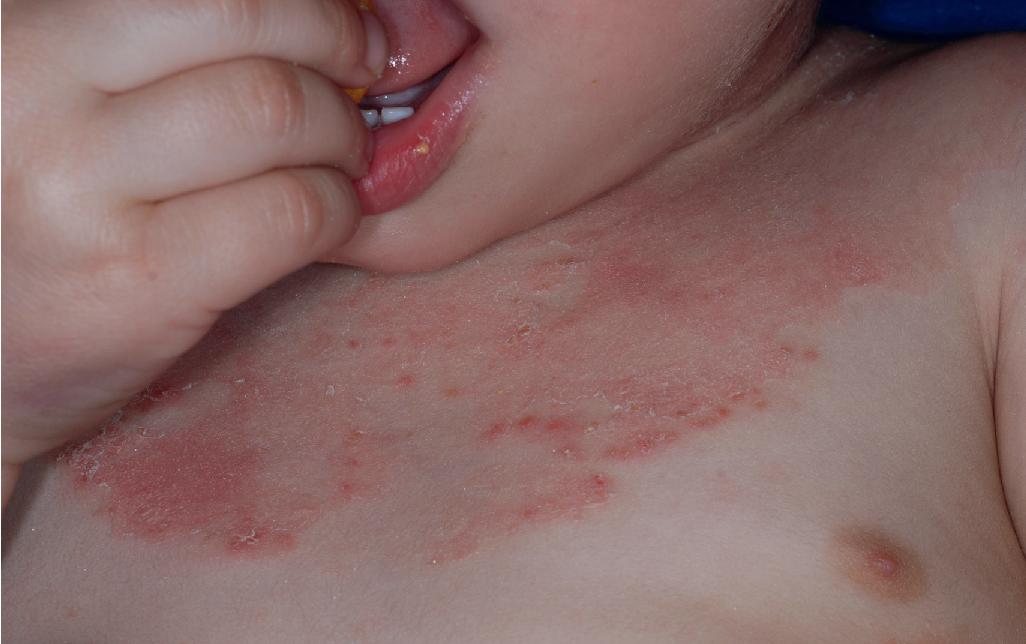
Psoriasis-like pustules during the neonatal period or in infancy, often in association with sterile multifocal osteomyelitis or periostitis, should also raise the possibility of inappropriate activation of IL-1 from biallelic variants in the IL-1 receptor antagonist (deficiency of IL-1 receptor antagonist [DIRA]). Pustules may be widespread or grouped and more localized. DIRA also may feature joint swelling and pain, oral stomatitis, and pyoderma gangrenosum, especially during childhood. , , Most neonates with DIRA are born prematurely.
Pustular psoriasis may also present after infancy in association with sterile lytic lesions of bone (sometimes called chronic recurrent multifocal osteomyelitis [ CRMO ]) as part of several syndromes. CRMO in association with congenital dyserythropoietic anemia and neutrophilic dermatoses comprises Majeed syndrome, an autosomal recessive disorder caused by mutations in LPIN2 . Synovitis, acne, pustulosis, hyperostosis, osteitis (SAPHO) syndrome (see Chapter 8 ) describes the constellation of synovitis, acne, palmoplantar pustulosis and psoriasis, hyperostosis, and osteitis and usually affects the bones of the lower limb, pelvis, and clavicle. , The bone and joint lesions can severely affect quality of life but may respond to immunosuppressive medications such as methotrexate and aggressive intervention for acne with isotretinoin.
Pustules overlying erythroderma can also be an occasional feature of patients with variants in CARD14, which typically has its onset during infancy or early childhood. More commonly, however, patients with CARD14 alterations often show signs of recalcitrant plaque-type psoriasis or PRP (see Pityriasis Rubra Pilaris section, later) and respond most rapidly to ustekinumab.
Patients with extensive pustular or erythrodermic psoriasis usually require hospitalization, and courses are not uncommonly complicated by cutaneous infection and bacterial septicemia. The disease is cyclic and associated with complete clearance of the pustular phase and unexplained exacerbations that span decades. Relapses are common and become progressively more severe, often with a poor prognosis. Unless localized and mild, management of pustular psoriasis usually requires systemic medications (e.g., retinoids, cyclosporine, methotrexate, and biologics; see Systemic Medications). Children with DITRA have been shown to have a higher recurrence rate after discontinuation of systemic retinoids than children with GPP without the IL36RN variant. Pediatric patients with DIRA often respond rapidly to subcutaneous administrations of anakinra 2 to 4 mg/kg per day.
Many of the comorbidities experienced by adults with psoriasis also occur in children. As such, affected children should receive routine screening in collaboration with pediatricians, with referral to rheumatologists, gastroenterologists, endocrinologists, and cardiologists as appropriate (see Table 4.3 ). Pediatric patients with moderate to severe plaque psoriasis have demonstrated impaired physical, emotional, social, and school functioning in comparison to healthy children, on par with children who have arthritis or asthma, and to a greater extent than children with diabetes. In one study, 65% of children with psoriasis experienced stigmatization and 43% complained about fatigue. Indeed, pediatric patients with psoriasis have a higher risk of developing psychiatric disorders, especially depression and anxiety. , The risk of these neuropsychiatric issues is further compounded by the increased risk of having other medical issues, particularly the most common comorbidity, obesity.
| Medication | Use in Children | Potential Side Effects and Comments |
|---|---|---|
| Emollients | Useful in mild disease; adjunct | None |
| Topical steroids | First-line therapy | Local side effects: atrophy, striae Systemic side effects: impaired growth, adrenal suppression, cataracts, tachyphylaxis |
| Calcitriol or calcipotriene | Usually adjunct with steroids | Irritation |
| Tacrolimus/pimecrolimus | Face, intertriginous areas | Burning with initial applications |
| Tazarotene | Usually adjunct with steroids | Irritation |
| Tar | Thicker plaques | Irritation, staining, folliculitis |
| Anthralin | Short contact application | Irritation; less staining than tar |
| Salicylic acid | Thicker plaques; usually compounded with steroids ± tar | Irritation |
Obesity (defined as having a body mass index [BMI] at the 95th percentile or higher) occurs in 38.5% of children with moderate to severe psoriasis and tends to precede the onset of psoriasis by at least 2 years in more than 90% of affected children. In one study, the odds ratio (OR) of being obese at the time of psoriasis onset was 2.58 (confidence interval [CI], 1.48 to 4.52). , Being overweight (“excess adiposity,” 85th to <95th percentile BMI) or obese occurs in pediatric psoriasis with an OR of 2.65 (95% CI, 1.70 to 4.15) globally; in the United States, the OR is 4.22 (CI, 2.05 to 8.67). Although obesity is linked to greater severity, excess adiposity is not dependent on psoriasis severity. Although the association is not as high as with psoriasis, a study of 320 children with JPsA demonstrated that almost 20% were obese and 36.3% overweight. Waist circumference percentile and waist-to-height ratio, which are both better indicators of metabolic risk than BMI percentile, are only increased in children with moderate to severe psoriasis. Early evidence suggests that aggressive therapy for psoriasis does not lead to reductions in weight or waist circumference.
In a study of 20 US children with psoriasis, metabolic syndrome (as defined by having at least three of the following: elevated triglycerides, high-density lipoprotein cholesterol, fasting blood glucose, waist circumference percentile, and blood pressure) occurred in 30% of those with psoriasis but 5% of the control group ( p <0.05). , Although some studies have shown no association, others have suggested a 1.5- to 3-fold increased OR of having hyperlipidemia, hypertension, diabetes, metabolic syndrome, polycystic ovarian syndrome, nonalcoholic liver disease, and elevated hepatic transaminases. , These odds largely reflect the increase in obesity, and in one study the risk for these comorbidities was 42% to 64% higher among obese children with psoriasis than nonobese children without psoriasis. Although a longitudinal study is needed, these data suggest that early intervention with lifestyle modification may decrease the long-term metabolic risk for these children.
Inquiry about pain, joint swelling, or limping, as well as examination of the joints for arthritis, should be part of the routine evaluation. Joint pain has been described in approximately 10% of US children with moderate to severe psoriasis, although only 1% to 4% in European countries. , JPsA comprises about 7.5% of juvenile idiopathic arthritis, and criteria have been established by the International League of Associations for Rheumatology (ILAR). These include arthritis with psoriasis or arthritis and (1) a family history of confirmed psoriasis in a parent or sibling, (2) dactylitis, or (3) nail pitting or onycholysis. The diagnosis is excluded if the patient has a positive rheumatoid factor titer or signs of systemic disease (daily fever, evanescent erythematous eruption, generalized adenopathy, hepatomegaly or splenomegaly, or serositis).
The occurrence of JPsA is biphasic. Younger children affected by psoriatic arthritis tend to be female with dactylitis and small-joint involvement that is more likely to progress and persist. The swelling often includes the juxtaarticular tissue, resulting in a blunt, “sausage-shaped” appearance of the involved fingers or toes. Progression to polyarthritis occurs in 30%, leading to flexure deformities and severe bone destruction (osteoporosis, shortening and tapering of the involved distal phalanx) with long-standing disease. On radiologic examination, this resembles a sharpened pencil (the so-called “pencil-in-cup” or “pencil-and-goblet” deformity) at the metatarsophalangeal and metacarpophalangeal joints. However, 72% have their onset when older than 4 years, with a male predominance and high prevalence of enthesitis and axial joint disease. Psoriatic skin lesions occur in approximately 60% of children with psoriatic arthritis, are identical to those seen in patients who do not manifest joint disease, and are not related in severity to that of the joint disease. Either skin disease or arthritis may develop initially, and in most patients flares of joint and skin disease do not correlate. Rheumatoid arthritis is also seen with increased frequency in children with psoriasis; in one cross-sectional register study in Denmark, the OR of having JPsA was 10.08 (95% CI, 7.97 to 12.74) and of rheumatoid arthritis 6.61 (95% CI, 2.75 to 15.87). ,
The risk of developing Crohn’s disease has been found to be higher in pediatric psoriasis, but the possibility of increased risk of ulcerative colitis is controversial. Asymmetric anterior uveitis has been described in 14% to 17% of children with JPsA. The cutaneous lesions of psoriasis may develop several years after the onset of persisting uveitis. Vitiligo and asthma , have recently been linked to pediatric psoriasis.
The diagnosis of psoriasis can usually be made clinically, although biopsy can be performed if the diagnosis is in question. Biopsy sections show epidermal thickening (acanthosis with elongation of the rete ridges), retention of nuclei in the stratum corneum (parakeratosis), and a mononuclear infiltrate. Focal collections of neutrophils in the stratum corneum or subcorneal layer (Munro microabscesses) are an additional feature in biopsies from patients with pustular psoriasis. Skin biopsies in DIRA and DITRA show features similar to those seen in pustular psoriasis.
Most patients have long-term mild to moderate disease, often with plaques confined to areas of frictional trauma such as the elbows, knees, buttocks, and scalp. The course of psoriasis, however, is unpredictable, ranging from spontaneous remissions to frequent exacerbations without an evident trigger. Although sunlight generally is beneficial and often leads to improvement during the summer, sunburns can elicit the Koebner phenomenon and lead to exacerbation. With appropriate therapy, satisfactory control of the disease is possible.
Guttate psoriasis and plaque psoriasis are most commonly confused with dermatitis and other papulosquamous disorders described in this chapter, especially pityriasis rosea or pityriasis lichenoides chronica (PLC) ( Box 4.1 ). PRP is the hardest to differentiate, especially when involved areas are largely the palms, soles, elbows, and knees. Although follicular accentuation is classically seen in PRP, this finding may occasionally be present in psoriasis as well. Focal areas of sparing and sometimes more salmon coloration of PRP can help to distinguish the conditions clinically; biopsy sections of PRP may show perifollicular inflammation and alternating parakeratosis and orthokeratosis (stratum corneum without nuclei). Children with variants in CARD14 may present with plaque psoriasis (or sometimes erythrodermic/pustular types), PRP, or a phenotype that has characteristics of both psoriasis and PRP , ; facial erythema is often prominent. A plaque-type psoriasiform eruption and, less often, a generalized or annular pustular psoriatic eruption may follow Kawasaki disease (see Chapter 21 ). Psoriasiform dermatitis with a distribution that is often atypical for psoriasis and shows a Th1 (IFNγ) immunophenotype is a common occurrence in children taking TNF inhibitors, especially for Crohn’s disease (see later). Generalized and localized forms of pustular psoriasis can be differentiated from infectious causes of pustulosis by cultures and from noninfectious conditions, such as eosinophilic folliculitis or infantile acropustulosis, by biopsy. Psoriasiform dermatitis may also be seen in boys with immune dysregulation, polyendocrinopathy, enteropathy, or X-linked (IPEX) syndrome (see Chapter 3 ). Atypical cases of psoriatic arthritis must be differentiated from other types of juvenile idiopathic arthritis or systemic lupus erythematosus.
| Comorbidity | When to Screen | Recommendation for Screening |
|---|---|---|
| Obesity and overweight | Yearly monitoring starting at 2 years of age | Body mass index (BMI) percentile |
| Diabetes | Every 3 years if overweight (if risk factors) or obese, starting at 10 years or onset of puberty | Fasting serum glucose |
| Hyperlipidemia | 9–11 years old; 17–21 years old More often if cardiovascular risk factors |
Fasting lipid panel |
| Hypertension | Yearly starting at 3 years of age | Blood pressure measurement |
| Nonalcoholic fatty liver disease (NAFLD) | If overweight (and other risk factors) or obese starting 9–11 years of age; earlier if very obese or family history of NAFLD | Alanine aminotransferase level |
| Arthritis | Any age | By history and examination |
| Inflammatory bowel disease | At any age | By history of gastrointestinal problems or unexplained weight loss |
| Psychiatric issues | Yearly screening, regardless of age, but consider substance abuse starting at 11 years of age | Screen with questions about feeling anxious, worrying, depressed or hopeless; interest or pleasure in activities * |
* Modified from Osier E, Wang AS, Tollefson MM, et al. Pediatric psoriasis comorbidity screening guidelines. JAMA Dermatol. 2017;153(7):698–704.
Become a Clinical Tree membership for Full access and enjoy Unlimited articles
If you are a member. Log in here